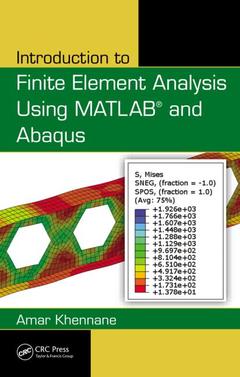Description
Introduction to Finite Element Analysis Using MATLAB and Abaqus
Author: Khennane Amar
Language: English
Subject for Introduction to Finite Element Analysis Using MATLAB and...:
Keywords
Dialog Box; Stiffness Matrix; stiffness; Global Force Vector; matrix; Global Stiffness Matrix; dialog; Equivalent Nodal Loads; box; Shape Functions; shape; Steering Vector; functions; Gauss Points; method; Prompt Area; nodal; 2nd Node; displacement; Nodal Displacements; main; Free Degrees; Linear Triangular Element; Internal Hinge; Trial Function; Jacobian Deriv; Rigid Jointed Frames; ELEMENT FORCE VECTOR; Main Menu; End DISP; Node Set; Keyword Edition; L2 2EI; Global Coordinates; Beam Column Element
Support: Print on demand
Description
/li>Contents
/li>Biography
/li>
There are some books that target the theory of the finite element, while others focus on the programming side of things. Introduction to Finite Element Analysis Using MATLAB® and Abaqus accomplishes both. This book teaches the first principles of the finite element method. It presents the theory of the finite element method while maintaining a balance between its mathematical formulation, programming implementation, and application using commercial software. The computer implementation is carried out using MATLAB, while the practical applications are carried out in both MATLAB and Abaqus. MATLAB is a high-level language specially designed for dealing with matrices, making it particularly suited for programming the finite element method, while Abaqus is a suite of commercial finite element software.
Includes more than 100 tables, photographs, and figures
Provides MATLAB codes to generate contour plots for sample results
Introduction to Finite Element Analysis Using MATLAB and Abaqus introduces and explains theory in each chapter, and provides corresponding examples. It offers introductory notes and provides matrix structural analysis for trusses, beams, and frames. The book examines the theories of stress and strain and the relationships between them. The author then covers weighted residual methods and finite element approximation and numerical integration. He presents the finite element formulation for plane stress/strain problems, introduces axisymmetric problems, and highlights the theory of plates. The text supplies step-by-step procedures for solving problems with Abaqus interactive and keyword editions. The described procedures are implemented as MATLAB codes and Abaqus files can be found on the CRC Press website.
Introduction. Bar Element. Beam Element. Rigid Jointed Frames. Stress And Strain Analysis. Weighted Residual Methods. Finite Element Approximation. Numerical Integration. Plane Problems. Axisymmetric Problems. Thin and Thick Plates.
Dr. Amar Khennane is a senior lecturer in the School of Engineering and Information Technology at the University of New South Wales, Canberra, Australian Capital Territory, Australia. He earned his PhD in civil engineering from the University of Queensland, Australia; a Master of Science in structural engineering from Heriot-Watt University, United Kingdom; and a bachelor’s degree in civil engineering from the University of Tizi-Ouzou, Algeria. His teaching experience spans 20 years, and two continents. He has taught structural analysis, structural mechanics, and the finite element method at various universities.




